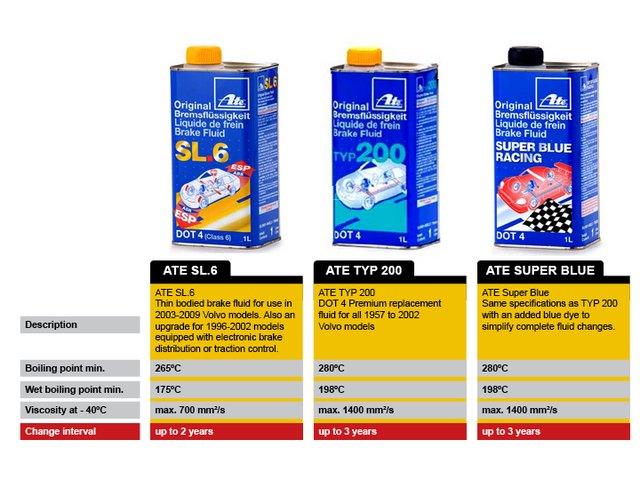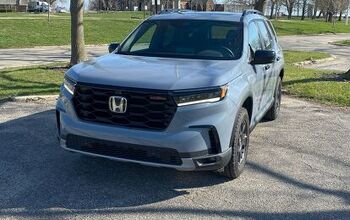Keep Color Choices Fluid

This past Friday, Jack reported on Continental’s decision to remove its ATE Super Blue brake fluid from the market, citing its non-compliance with federal motor vehicle safety standards. Apparently, Super Blue ran afoul of regulations regarding the coloration of brake fluid in motor vehicles. It’s not clear exactly what led Continental to recall the product now after years on the market, but it’s obvious why: blue brake fluid is a no-go according to American regulators. As Jack pointed out, this apparent government overreach has cost consumers another choice that amateur racers in particular found useful. Commenters on that story debated the relative merits of regulating automotive fluid colors, in particular brake fluid. So just how regulated are fluid colors anyway, and do those regulations help or hurt consumers overall?
Federal Motor Vehicle Safety Standard 116 is the part of the NHTSA’s safety code that outlines minimum requirements for brake fluid. Section 5.1.14 specifies color requirements for brake fluid. DOT 3, 4, and 5.1 (the normal glycol-based fluids in most modern cars) must be colorless to amber. High-performance DOT 5 silicone-based fluid must be purple, and mineral oil fluid for other hydraulic systems must be green. These standards were first promulgated in the early Seventies as part of the general package of regulations then coming into force on the auto market. Before the feds stepped in, many individual states had already begun to regulate brake fluid, rightly sensing its safety implications. Setting minimum requirements for brake fluid’s performance seems like a completely fair piece of regulation that few enthusiasts or regular consumers would disagree with. Still, it’s not immediately apparent why regulators felt it necessary to specify a color range for the fluid. Some commenters mentioned that the intent might have been to make a clear distinction between brake fluid and other under-hood liquids. In the early Seventies, when fluid colors were less diverse, that made sense. However, more recent developments in fluid coloration mean that regulators have fallen short of their goal.
It turns out that brake fluid is the only automotive fluid whose color is explicitly regulated, at least on a federal level. A long search through the NHTSA’s standards didn’t turn up any evidence that antifreeze, automatic transmission fluid, oil, windshield washer spray, power steering fluid, or any other kind of liquid is explicitly regulated by color. And a quick trip to O’Reilly or a Google search will reveal that previously mundane fluids are now available in a rainbow of colors. It seems that manufacturer consensus, rather than any specific regulation, is what led to widespread usage of specific colors for fluids such as antifreeze and ATF in the past. The diversification of technology in particular is driving the use of a much wider color palette for these fluids. This bulletin from an industry trade group known as the Filter Manufacturer’s Council outlines the shift away from usage of a single color (bright green) by antifreeze makers. Red, yellow, pink, orange, and blue are some of colors that antifreeze is now available in. And as the bulletin states, no color corresponds to any particular type.
Other kinds of fluids are increasingly available in a variety of colors. The widespread introduction of CVT’s has brought on a new wave of color choices for transmission fluid. Windshield washer fluid comes in many different types. There doesn’t seem to be any favored choice for power steering fluid, with manufacturers using a wide variety of tints. Regular motor oil and gasoline both seem to be sticking with their typical light brown and yellowish hues for the time being. The carboniferous chemical content of oil may limit what manufacturers can do to change the color of those particular fluids. Of course, that hasn’t stopped the makers of full synthetic oil from diversifying their color choices. Who doesn’t want to slather all their important mechanical parts in shades of deep purple? The net result is that brake fluid is no longer distinct in color from many other under-hood fluids. Motor oil is just as likely to be amber, as are many others. Even completely clear fluid wouldn’t be different from some coolants and windshield washer sprays. The utility of regulating brake fluid color has been limited by a market that has grown up unregulated around it.
So where does all of this diversification leave the consumer? It means that for every fluid except brake fluid, there’s a wide variety of choices to fit whatever possible situation might arise. Jack pointed out the usefulness of Super Blue for ensuring complete flushes of braking systems. Using different colored fluids in other vehicle systems could offer the same benefits. In addition, leaving color choices open-ended means that manufacturers are less technologically constrained in their development of better fluids. If a company develops a new and better kind of coolant but can only manufacture it in hot pink, they needn’t worry about the long arm of the law cracking down on account of the color. On the negative side, the wildly proliferating choice in color can be bewildering to consumers and even to seasoned professionals. The increasing crossover of colors between different types of fluids will inevitably lead to more mistakes. It also makes it harder to identify the source of leaks and other kinds of mechanical issues. In the past, red or green stains on the ground were easy to trace. Nowadays, it could be a fluid leak from any number of sources. As makers are increasingly eschewing the use of fluid dipsticks for sensors and a “take it to the dealer” mentality, this spells increased frustration for do-it-yourselfers.
Even so, I find that the pros of fluid color diversification outweigh the cons, from both an enthusiast and a regular consumer standpoint. Fewer restraints on development benefit everybody, because it encourages manufacturers to seek out new markets and better ways of doing things. As long as minimum safety standards are met, the risk to the consumer is minimized. It would be one thing if Super Blue didn’t meet minimum standards for performance, but that isn’t the case. Super Blue got yanked from the market because of a well-intentioned but outdated piece of regulation that no longer serves the best interest of consumers. The only real way to keep the regulatory dream of standardized fluid colors alive at this point would be a sweeping crackdown on different-colored fluids across the market. That would hurt both manufacturers and consumers in the short run, and it might artificially limit technological development in the future. Given the current state of affairs, deregulating the color of brake fluid is a win for both manufacturers and consumers.

More by J.Emerson
Latest Car Reviews
Read moreLatest Product Reviews
Read moreRecent Comments
- Lou_BC "That’s expensive for a midsize pickup" All of the "offroad" midsize trucks fall in that 65k USD range. The ZR2 is probably the cheapest ( without Bison option).
- Lou_BC There are a few in my town. They come out on sunny days. I'd rather spend $29k on a square body Chevy
- Lou_BC I had a 2010 Ford F150 and 2010 Toyota Sienna. The F150 went through 3 sets of brakes and Sienna 2 sets. Similar mileage and 10 year span.4 sets tires on F150. Truck needed a set of rear shocks and front axle seals. The solenoid in the T-case was replaced under warranty. I replaced a "blend door motor" on heater. Sienna needed a water pump and heater blower both on warranty. One TSB then recall on spare tire cable. Has a limp mode due to an engine sensor failure. At 11 years old I had to replace clutch pack in rear diff F150. My ZR2 diesel at 55,000 km. Needs new tires. Duratrac's worn and chewed up. Needed front end alignment (1st time ever on any truck I've owned).Rear brakes worn out. Left pads were to metal. Chevy rear brakes don't like offroad. Weird "inside out" dents in a few spots rear fenders. Typically GM can't really build an offroad truck issue. They won't warranty. Has fender-well liners. Tore off one rear shock protector. Was cheaper to order from GM warehouse through parts supplier than through Chevy dealer. Lots of squeaks and rattles. Infotainment has crashed a few times. Seat heater modual was on recall. One of those post sale retrofit.Local dealer is horrific. If my son can't service or repair it, I'll drive 120 km to the next town. 1st and last Chevy. Love the drivetrain and suspension. Fit and finish mediocre. Dealer sucks.
- MaintenanceCosts You expect everything on Amazon and eBay to be fake, but it's a shame to see fake stuff on Summit Racing. Glad they pulled it.
- SCE to AUX 08 Rabbit (college car, 128k miles): Everything is expensive and difficult to repair. Bought it several years ago as a favor to a friend leaving the country. I outsourced the clutch ($1200), but I did all other work. Ignition switch, all calipers, pads, rotors, A/C compressor, blower fan, cooling fan, plugs and coils, belts and tensioners, 3 flat tires (nails), and on and on.19 Ioniq EV (66k miles): 12V battery, wipers, 1 set of tires, cabin air filter, new pads and rotors at 15k miles since the factory ones wore funny, 1 qt of reduction gear oil. Insurance is cheap. It costs me nearly nothing to drive it.22 Santa Fe (22k miles): Nothing yet, except oil changes. I dread having to buy tires.




































Comments
Join the conversation
I for one welcome the efforts of the government to protect our precious automotive and bodily fluids....
My anti freeze is a milky grey color. I am going to call Congress and demand they remedy this!